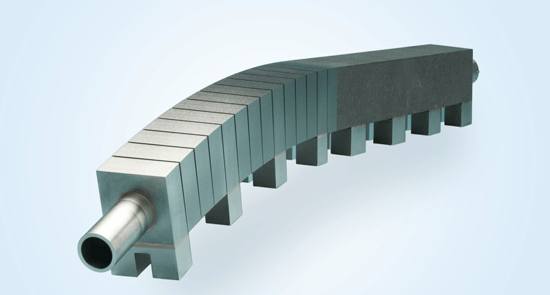ITER nuclear fusion heat exchanger set for series production using Plansee expertise
Only components that meet the most stringent technical requirements can be considered for use in the ITER system. Above all, the heat exchangers of the diverter are subject to extreme temperatures.
Plansee states that is has recently reached the final qualification phase prior to series manufacture with its components and is now looking to become established as one of the key suppliers to ITER.
Seven nations are currently working together on building a nuclear fusion plant as part of ITER, the world’s most extensive fusion experiment. For the first time, the plant is intended to deliver more power than is required for generating and maintaining the plasma. Some of the requirements on the components stretch the limits of what can be achieved with today’s technology.
Test scale components from Plansee have already proved themselves and have made a significant contribution to the reference design of the forthcoming ITER plant. Plansee was recently awarded the contract for manufacturing full-scale prototypes. This final stage before series manufacturing is a serious challenge, and only three companies worldwide were able to qualify.
How does nuclear fusion work?
Energy is released when hydrogen nuclei fuse to form helium nuclei. That is the simple recipe for success behind this environmentally friendly and sustainable source of energy. The shining example of this process is the sun, which also generates energy using the same principle. But although it may sound simple, it is in fact the result of the complex interplay of many factors.
In the nuclear fusion plant, hydrogen gas will be heated to temperatures in excess of 100 million °C. This produces a plasma in which the electrons are separated from the nuclei. At these extreme temperatures, hydrogen nuclei possess sufficient kinetic energy to collide with each other despite the repulsive electric force between them and fuse to form helium nuclei. Recoverable energy is released during this nuclear fusion process.
A magnetic field encloses the hot plasma in order to maintain the fusion process and to protect the components of the plant as well as possible. Only very few components come into contact with the outer regions of the plasma. One area which becomes particularly hot is the divertor.
At particular points in the magnetic field, generally near the bottom of the plasma vessel, the helium ions and impurities in the plasma are guided towards the divertor. There, the ions are slowed down and electrically neutralised. In order to prevent the divertor components from melting or even vapourising, the heat that has been generated must be removed as quickly as possible.
If the divertor is unable to withstand the extreme stress, the continuous operation of the fusion plant is simply not possible. As a result, only composites that can withstand an extremely high level of generated heat of up to 20 MW/m² and are capable of resisting the ceaseless attack of electrons, ions and impurities are used in the divertor.

The current reference design for the high-performance heat exchangers for the ITER divertor involves monoblocks manufactured from tungsten and carbon fibre reinforced graphite (CFC) that are joined to a CuCrZr alloy tube using a patented joining technology. The channel sections on the bottom are manufactured from special steel and are intended to be used later for connecting the assembly to the support structure of the ITER divertor. The figure shows a prototype having approximately 25% of the final overall length
In principle, the divertor is made up of a highly efficient heat sink for dissipating the heat protected by an armour. The armour protects the heat sink from being damaged by the hot plasma during operating conditions.
Tungsten and carbon are the materials of choice for this armour. These materials are particularly heat resistant and dissipate heat very efficiently. Unlike carbon, tungsten does not bind a large amount of hydrogen and has a low interaction with the plasma resulting in lower impurity levels of the plasma. This makes tungsten a particularly suitable material in highly loaded areas of the first wall of nuclear fusion plants.
As a leading expert for refractory metals, Plansee manufactures armor composites for the divertor made from carbon fibre reinforced carbon (CFC) and tungsten monoblocks and joins the armour to the copper/chromium/zirconium-based heat sinks. Plansee states that its particular expertise lies not only in the resilient materials themselves, but also in the joining technology used within the composite.
Once the fusion plant has been taken into operation, any repairs represent a huge outlay in terms of time and money. Any downtime of the plant, no matter how short, is an expensive exercise. Only a perfect joint between the armour and the heat sink prevents overheating and damage to the divertor. Plansee has developed and patented its own joining process specifically for the nuclear fusion industry: “active metal casting”. This method ensures that heat is transmitted to the heat sink extremely efficiently and reliably.
Over the course of the coming months, the team from Plansee will be working together with a large number of engineers and production staff to construct the first full-scale partial segments of the divertor for ITER. All the individual steps in production must be perfectly coordinated and technically harmonised.
Joining some 130 armour blocks to the backing tubes of the heat sink in a single step without the slightest error is just one of the many challenges to be overcome during the project. Traditional quality assurance measures are not appropriate to the complexity of this development task. In order to be absolutely certain, Plansee has developed its own non-destructive testing methods for ITER based on thermographic and ultrasound techniques.
Stress testing on all ITER prototypes should be completed successfully by mid-2014. Series production of the ITER components can then start.
News | Articles | Market reviews | Search directory | Subscribe to e-newsletter





